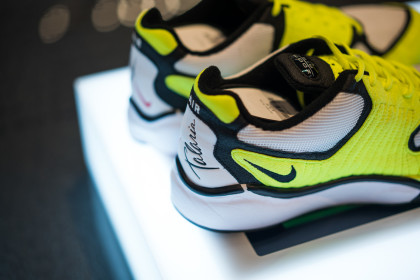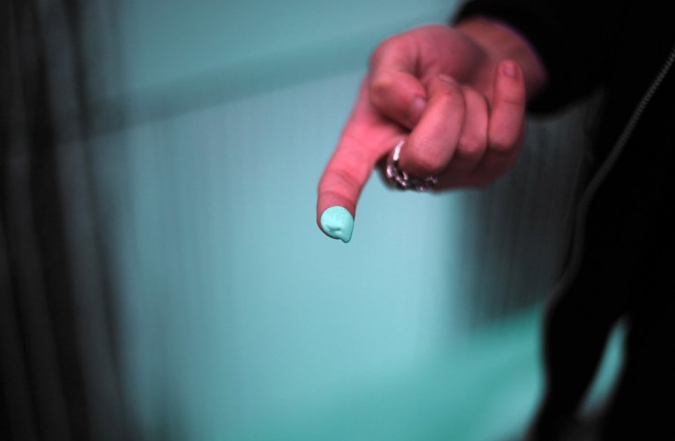
Graffiti Wars
Graffiti artists have been collaborating with the big names fashion for quite a while now, so when I got wind of Kongo‘s new deal with Hermes, I wasn’t so much shocked or curious about it, but intrigued as to what the fallout might for both the artist, and Hermes’ storefronts, over the next for weeks and months.
For those unfamiliar with Kongos work, he’s most well known for his street art, and the time he spent creating the M.A.C crew. He’s considered one of the most prominent figures to emerge in the French graffiti scene over the last 20 years.
While he’s now considered a full-fledged artist having taken his work off the streets and into galleries around the world, his street cred remains intact… for the time being.
But like the slew of other street artists to sign on with a high end fashion brand – Stephen Sprouse and Marc Jacobs in 2001 is by far the best known collaboration – criticism ensues any kind of big name collaboration. (Actually, Sprouse isn’t recognized by many street based artists as a legitimate graffiti artist at all. His technical ability has been harshly bashed.)
Brands use these artists to divest themselves of a stuffy brand image. Brands that want to seem “in the know” and “connected” are looking to the streets and the younger “urban” crowds to do it.
But hey, if the artists are ok with lending their talent to the mass market (and with the kind of hefty paycheck that comes along with the type of deal big fashion brands are offering, even the most steadfast artist is sure to look twice,) no harm no foul, right?
Life’s never quite that simple.
Enter KIDULT, a graffiti artist who is nearly as keen to see his work featured on storefronts as is the hoard of street artists that have come running to the call of big fashion brands. But here’s the kicker: he’ll throw up a piece for free. He also doesn’t wait to be asked to start working. His guerilla tactics include bombing any of the major retail locations linked to brands that have sought out graffiti artists to revive their aging brands.
This short documentary came out in July and features KIDULT basically doing his thing, and explaining his beef with some brands new found appreciation for his chosen art form.
If you’re going to exploit graffiti art, KIDULT figures you might as well get what you’re paying for. Most recently Hermes was hit (I guess that answers that question!), but Agnès B. as well has made the list, along with Yves Saint Laurent, Kenzo, Supreme and Colette. Few if any of the brands (save for a cute tweet care of Agnès B.) react to his hits, besides washing off the paint. No comments are generally made to the press either.
Whatever side of the debate you’re on, it’s safe to say that like all art, it’s a question of personal conviction when it comes to who you sell your work to, and why. But KIDULT’s response is nonetheless interesting. He’s not expressing jealous frustration at not having his own deal, but fear that the essence of his chosen style of art – the grassroots, on the fly momentum, the counter-cultural quality – with be forever altered, and generalized by popular culture, all in the name of the quick buck. With the reputation popular culture has for, well, destroying the good in anything it touches, I suppose I’d be worried too…
[Below, some examples from around the web of collaborations, and a few of the shops that KIDULT has taken on.]
Graffiti artists have been collaborating with the big names fashion for quite a while now, so when I got wind of Kongo's new deal with Hermes, I wasn't so much shocked or curious about it, but intrigued as to what the fallout might for both the artist, and Hermes' storefronts, over the next for weeks and months.
For those unfamiliar with Kongos work, he's most well known for his street art, and the time he spent creating the M.A.C crew. He's considered one of the most prominent figures to emerge in the French graffiti scene over the last 20 years.
While he's now considered a full-fledged artist having taken his work off the streets and into galleries around the world, his street cred remains intact... for the time being.
But like the slew of other street artists to sign on with a high end fashion brand - Stephen Sprouse and Marc Jacobs in 2001 is by far the best known collaboration - criticism ensues any kind of big name collaboration. (Actually, Sprouse isn't recognized by many street based artists as a legitimate graffiti artist at all. His technical ability has been harshly bashed.)
Brands use these artists to divest themselves of a stuffy brand image. Brands that want to seem "in the know" and "connected" are looking to the streets and the younger "urban" crowds to do it.
But hey, if the artists are ok with lending their talent to the mass market (and with the kind of hefty paycheck that comes along with the type of deal big fashion brands are offering, even the most steadfast artist is sure to look twice,) no harm no foul, right?
Life's never quite that simple.
Enter KIDULT, a graffiti artist who is nearly as keen to see his work featured on storefronts as is the hoard of street artists that have come running to the call of big fashion brands. But here's the kicker: he'll throw up a piece for free. He also doesn't wait to be asked to start working. His guerilla tactics include bombing any of the major retail locations linked to brands that have sought out graffiti artists to revive their aging brands.
This short documentary came out in July and features KIDULT basically doing his thing, and explaining his beef with some brands new found appreciation for his chosen art form.
If you’re going to exploit graffiti art, KIDULT figures you might as well get what you’re paying for. Most recently Hermes was hit (I guess that answers that question!), but Agnès B. as well has made the list, along with Yves Saint Laurent, Kenzo, Supreme and Colette. Few if any of the brands (save for a cute tweet care of Agnès B.) react to his hits, besides washing off the paint. No comments are generally made to the press either.
Whatever side of the debate you're on, it’s safe to say that like all art, it's a question of personal conviction when it comes to who you sell your work to, and why. But KIDULT’s response is nonetheless interesting. He’s not expressing jealous frustration at not having his own deal, but fear that the essence of his chosen style of art – the grassroots, on the fly momentum, the counter-cultural quality – with be forever altered, and generalized by popular culture, all in the name of the quick buck. With the reputation popular culture has for, well, destroying the good in anything it touches, I suppose I’d be worried too…
[Below, some examples from around the web of collaborations, and a few of the shops that KIDULT has taken on.]

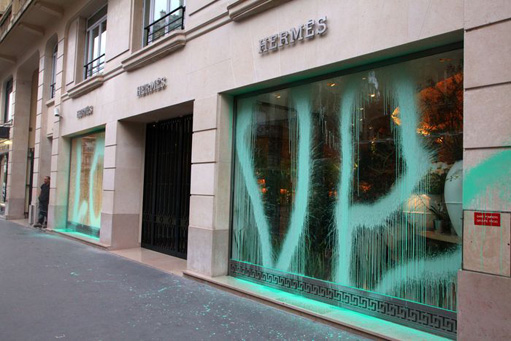
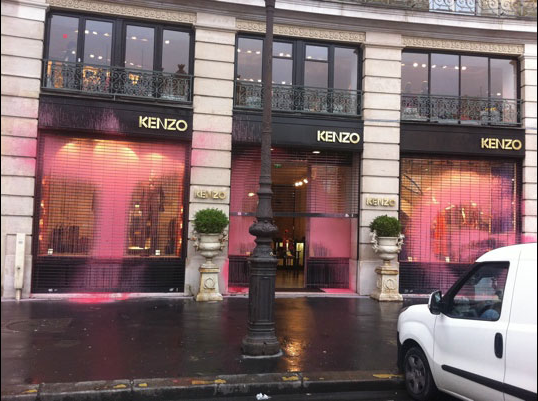
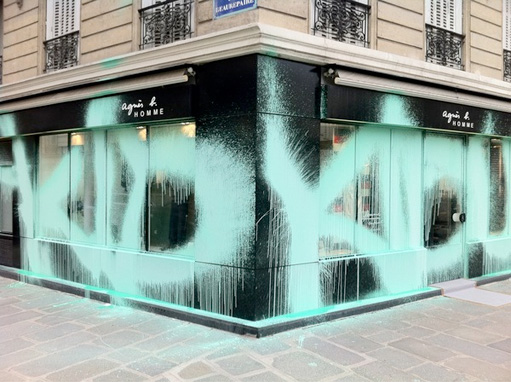
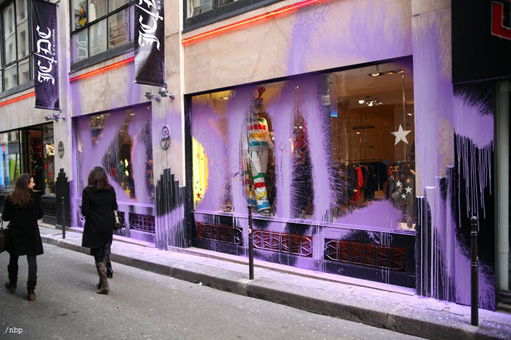
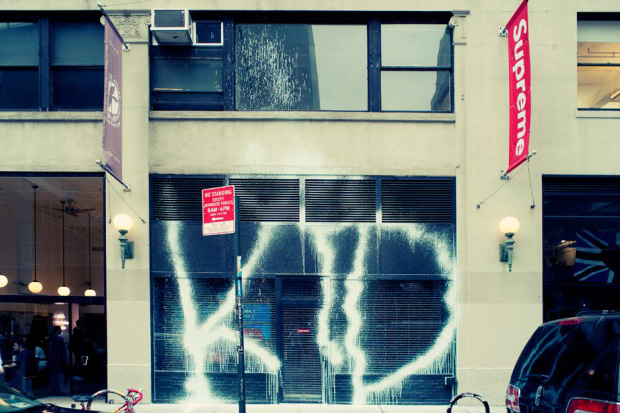 View all images
View all images




